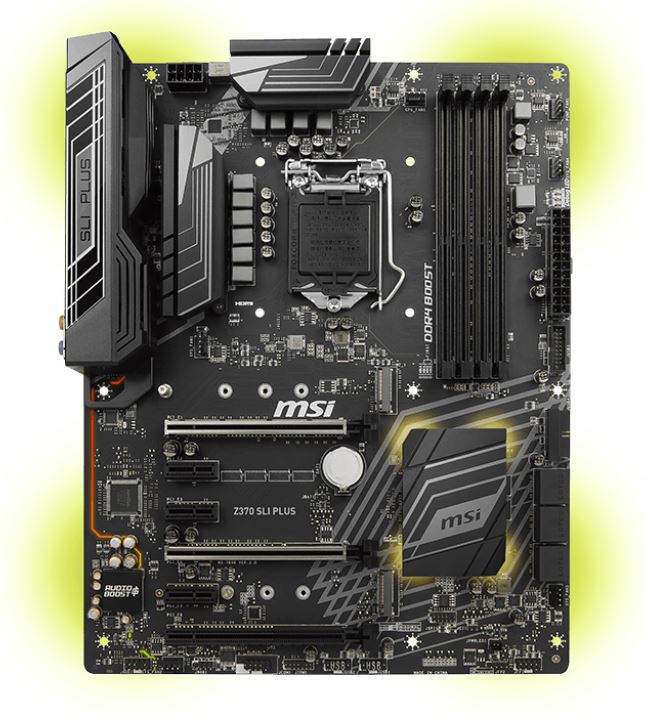Analyzing Z370 for Intel's 8th Generation Coffee Lake: A Quick Look at 50+ Motherboards
by Ian Cutress, Anton Shilov, Joe Shields & Gavin Bonshor on October 20, 2017 2:00 PM ESTMSI Z370 SLI Plus
The MSI Z370 SLI Plus sits as the next installment on a very successful SLI Plus line from MSI. On some chipsets, the SLI Plus sits as one of the cheapest boards that still boasts extra features, with the key one being SLI but also going full-bore with the MSI software stack. Compared to some of the other Z370 'Pro' series boards, this board has multiple PCIe slots using reinforcement, shrouding on the back panel IO, a higher phase count power delivery, and uses the latest Realtek ALC1220 audio codec.
The SLI Plus’ appearance isn’t much different than some of the other mid-level boards MSI is releasing for Z370. It is a black on black theme, with on-PCB stencil design elements around the chipset, chipset heatsink, and power delivery. There are two heatsinks to keep the power delivery cool, although they are not heatpiped together. RGB LEDs are found under the chipset heatsink, as well as on the back of the board and in the audio separation line. There is one RGB header on the board for adding another RGB LED strip.
The four memory slots are not strengthened on the SLI Plus, but use single sided clips to allow for easy installation when other large GPUs are present. The board supports up to 64GB of memory, with speeds up to DDR4-4000+. The top two full-length PCIe slots are powered by the CPU in an x16 or x8/x8 configuration, and use MSI's structural reinforcement. The third full-length PCIe slot is from the chipset and does not have reinforcement.
Like almost every board in the roundup so far, the SLI Plus has six SATA ports supporting RAID 0, 1, 5, and 10. Additionally, there are two M.2 slots, with one found above the top PCIe slot and a second between the last two full-length slots. The top M.2 location can fit up to 110mm drives while the bottom supports up to 80mm.
A total of six 4-pin hybrid controlled (PWM/voltage) fan headers can also be found, with four around the socket and two towards the bottom of the board. The Realtek ALC1220 codec is used for audio, featuring an EMI shield and PCB separation. Networking duties are handled by the Intel I219-V controller.
The rear panel has two USB 3.1 (10 Gbps) ports, one Type-A and Type-C, handled by the ASMedia ASM3142 controller. Users will get four USB 3.1 (5 Gbps) ports and two USB 2.0 ports on the rear panel also, with two headers from each for front panel connectors. The rest of the rear panel contains a combination PS/2 port, DVI-D and HDMI for video outputs, the Intel network port, and audio jacks with SDPIF.













83 Comments
View All Comments
tommythorn - Monday, October 23, 2017 - link
While that feature page is great, the thunderbolt part is slightly misleading as a few of them supports it via an add-in-card. The page only lists the one that has it built-in. (The lackluster support for TB3 as well as 10 GbE is disappointing).OFelix - Saturday, October 21, 2017 - link
ThanksStochastic - Friday, October 20, 2017 - link
Would you consider putting out some simple Wirecutter-style recommendations? A lot of people (including myself) would like someone else who is better informed to simplify the decision-making process.Ian Cutress - Friday, October 20, 2017 - link
When we get our Z370 reviews underway, we'll start doing some buyers guidesStochastic - Friday, October 20, 2017 - link
Great, thanks!IGTrading - Sunday, October 22, 2017 - link
When do we get a 50+ AMD motherboard article guys ? :)abrowne1993 - Friday, October 20, 2017 - link
Okay but which one looks the coolest?dave_the_nerd - Friday, October 20, 2017 - link
"Whoever thought this was a good idea at Intel needs to be fired."Well... gee... why don't you tell us how you really feel?
DigitalFreak - Friday, October 20, 2017 - link
This whole notch thing makes me wonder if the 8xxx series was originally supposed to work in existing motherboards, but Intel ran into issues at the last minute.KaarlisK - Saturday, October 21, 2017 - link
Honestly, I cannot see the issue. The pins were changed so that nothing bad will happen if you put the wrong CPU in the wrong motherboard.As for the notches, I for one am happy that they were not changed. This means they can reuse the physical design, which lowers validation costs, which makes the CPUs cheaper.